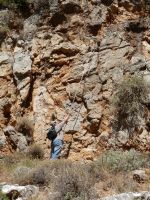

 This collecting expedition can be typified as a single crop expedition as the main target of the expedition was to sample three leek CWR. The collecting expedition took place in Greece, because in this country all three species can be found in nature. A. bourgeaui is endemic in Greece. A. commutatum has a broader distribution range compared to A. bourgeaui because it occurs also along the Adriatic coast. A. ampeloprasum has a very broad distribution range and can be found in the whole Mediterranean region and as far as Afghanistan in the East. A. bourgeaui and A. commutatum can be considered as specialists, because they occur in specific habitats. A. bourgeaui is a chasmophyte and can be found on limestone cliffs and inland rocky slopes; it occurs mostly in small populations. A. commutatum is a species which occurs in maritime habitats and can be found on islets and shores. The species is able to dominate completely the area occupied. A. ampeloprasum is a ruderal species which occurs in disturbed places such as cultivated and abandoned fields; population sizes range from small to large.
This collecting expedition can be typified as a single crop expedition as the main target of the expedition was to sample three leek CWR. The collecting expedition took place in Greece, because in this country all three species can be found in nature. A. bourgeaui is endemic in Greece. A. commutatum has a broader distribution range compared to A. bourgeaui because it occurs also along the Adriatic coast. A. ampeloprasum has a very broad distribution range and can be found in the whole Mediterranean region and as far as Afghanistan in the East. A. bourgeaui and A. commutatum can be considered as specialists, because they occur in specific habitats. A. bourgeaui is a chasmophyte and can be found on limestone cliffs and inland rocky slopes; it occurs mostly in small populations. A. commutatum is a species which occurs in maritime habitats and can be found on islets and shores. The species is able to dominate completely the area occupied. A. ampeloprasum is a ruderal species which occurs in disturbed places such as cultivated and abandoned fields; population sizes range from small to large.
The three wild species form the so-called "ampeloprasum" complex (sensu von Bothmer) and can be crossed successfully with their domesticated crop species leek.
Table 1: Overview of the number of accessions present in three databases covering most of the variation present in genebanks worldwide. GRIN: USDA genebanks; SINGER: CGIAR institutes; EURISCO: European genebanks.
| GRIN | SINGER | EURISCO | Total | |
| A. ampeloprasum | 49 | 2 | 47 | 98 |
| A. bourgeaui | 0 | 0 | 1 | 1 |
| A. commutatum | 0 | 0 | 0 | 0 |
| A. porrum | 51 | 12 | 1005 | 1068 |